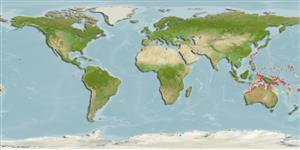Teleostei (teleosts) >
Perciformes/Scorpaenoidei (Scorpionfishes) >
Scorpaenidae (Scorpionfishes or rockfishes) > Scorpaeninae
Etymology: Scorpaenodes: Latin, scorpaena = a kind of fish, 1706 + Greek oides = similar to (Ref. 45335); quadrispinosus: From the Latin quattor meaning four and spina meaning spine, in reference to its diagnostic four suborbital spines (Ref. 46823).
More on authors: Greenfield & Matsuura.
Environment: milieu / climate zone / depth range / distribution range
Ecology
Marine; reef-associated; depth range 0 - 12 m (Ref. 90102). Tropical
Distribution
Countries | FAO areas | Ecosystems | Occurrences | Point map | Introductions | Faunafri
Indo-Pacific : Christmas Island to Fiji and the Marshall Islands northward to Ryukyu Islands southward to Papua New Guinea. Also recorded in Australia (Ref. 76833).
Size / Weight / Age
Maturity: Lm ? range ? - ? cm
Max length : 10.0 cm SL male/unsexed; (Ref. 76833)
Dorsal spines (total): 13; Dorsal soft rays (total): 10 - 11; Anal spines: 3; Anal soft rays: 5 - 6. Distinguished from all other Scorpaenodes species by having the first two spines on the suborbital ridge extending dorsally above the lower orbit margin; no distinct dark spot on opercle, subopercle, or spinous dorsal fin; pectoral fin rays usually 17; vertical scale rows 39-43; head and upper body light cream overlaid by dark brown to black pigment pattern; lower half of body light cream to white, edges of scales on lower half pink (Ref. 46823); Suborbital ridge with four spinules; presence of interorbital and coronal spines, small; depth of body 2.8-3.1 in SL (Ref. 90102).
Found in coral reefs in 0-12 m (Ref 90102).
Life cycle and mating behavior
Maturity | Reproduction | Spawning | Eggs | Fecundity | Larvae
Greenfield, D.W. and K. Matsuura, 2002. Scorpaenodes quadrispinosus: a new Indo-Pacific scorpionfish (Teleostei: Scorpaenidae). Copeia 2002(4):973-978. (Ref. 46823)
IUCN Red List Status (Ref. 130435: Version 2024-1)
Threat to humans
Harmless
Human uses
Tools
Special reports
Download XML
Internet sources
Estimates based on models
Preferred temperature (Ref.
123201): 26.1 - 29.4, mean 28.5 °C (based on 1225 cells).
Phylogenetic diversity index (Ref.
82804): PD
50 = 0.5000 [Uniqueness, from 0.5 = low to 2.0 = high].
Bayesian length-weight: a=0.01288 (0.00620 - 0.02676), b=3.03 (2.86 - 3.20), in cm total length, based on LWR estimates for this (Sub)family-body shape (Ref.
93245).
Trophic level (Ref.
69278): 3.6 ±0.5 se; based on size and trophs of closest relatives
Resilience (Ref.
120179): High, minimum population doubling time less than 15 months (Preliminary K or Fecundity.).
Fishing Vulnerability (Ref.
59153): Low vulnerability (10 of 100).
